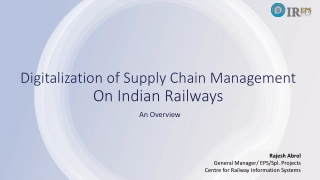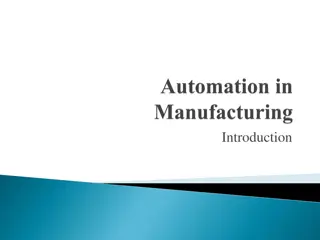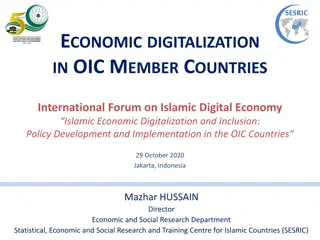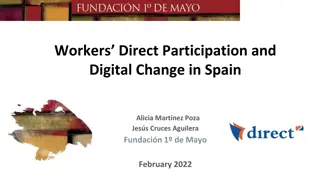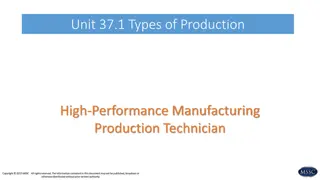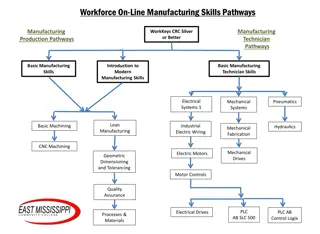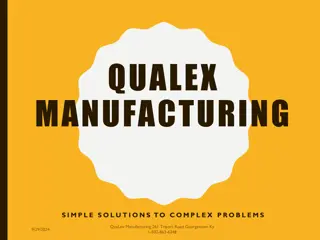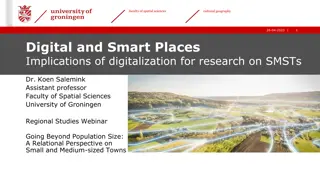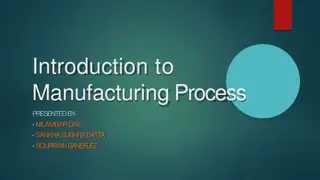Insights on Digitalization and Manufacturing in Developing Countries
This collection of images and descriptions presents a thoughtful analysis on the impact of digitalization and the Fourth Industrial Revolution on manufacturing in developing countries, with a focus on Africa. It discusses the transition to digital technologies, policy implications, labor productivity, and the potential for boosting industrial growth and employment. Key questions are raised regarding technology deployment, digital divide, and societal impact.
Download Presentation

Please find below an Image/Link to download the presentation.
The content on the website is provided AS IS for your information and personal use only. It may not be sold, licensed, or shared on other websites without obtaining consent from the author.If you encounter any issues during the download, it is possible that the publisher has removed the file from their server.
You are allowed to download the files provided on this website for personal or commercial use, subject to the condition that they are used lawfully. All files are the property of their respective owners.
The content on the website is provided AS IS for your information and personal use only. It may not be sold, licensed, or shared on other websites without obtaining consent from the author.
E N D
Presentation Transcript
Salesman: It runs on its conventional gasoline- powered engine until it senses guilt, at which point it switches over to battery power. 16
Comments on Digitalization & the Future of Manufacturing in Africa Dr. Anupam Khanna 18th GDN Annual Conference New Delhi, March 23, 2018
Outline General Remarks on Paper & Value-Addition Detailed Comments Already Communicated My Take-Aways Logic and Analytical Framework Key Findings & Policy Implications Alternative Approaches and Interpretations Issues Remaining Suggestions for Further Research
Value Added Although Focused on Africa, Useful for Other Developing Countries ... including India Valuable Job Pulling Together Literature on Experience in Industrialized Countries And Sobering Down the Hype Could Have Evaluated Methodologies More Critically Clarification of Definitions and Pathways Do Disagree with Several Aspects Statistical Analysis on Some African Countries
Implications 5 19-Sep-24
Analysis Approach Fourth Industrial Revolution driven by emerging technologies will impact manufacturing globally Can developing countries harness digital revolution to boost industrial growth & employment? How does a growing digital economy affect labor productivity in developing countries manufacturing What are the policy implications?
Asking the right question.. not whether but ..WHAT IF?
Some Questions I Have Deployment Time Frames for Various Technologies? Indeed should we focus on other digital technologies? Is it Digital Technologies that need Harnessing? Can you leapfrog into a digital post-industrial society Boost industrial output or employment? African (or developing) countries left behind how? Salient Digital Divide Within Country or Without? Finally is it private and/or social returns that are low?
SMAC Social Media, Mobility, Analytics and Cloud reshaping the future right now Mobile payments Smart cities Connected Health Pivot merchandising mBanking mHealth Smart Buildings mGovernance Platform-as-a-Service Drivers/ factors contributing to the changing landscape of Technology Impact is highly evident SMAC, is becoming a business reality Social, mobility, analytics and cloud are reshaping the business, the consumers and all traditional approaches, Indian Industry has seen till now Create a new digital operating model and transformation to a permeable enterprise Transformation Remodelling business processes through harmonizing technology advancement Movement towards the next orbit of innovation with consumerization of IT Engagement with a growing digital ecosystem Opportunity to move to higher-margin business by offering creative solutions Client- specific outcomes A meaningful change in the business requirements i.e., end-to-end solutions Empower enterprises to embrace emerging technology trends and to benefit from the value expectations of customers Help businesses grow dynamically instead of increasingly cutting margins for typical IT contracts Launching luxury product lines that comprise the SMAC suite of technologies to go the next level New paradigm for business Efficiency, Enhanced customer experience, Reduced time to market, Connectivity, IT Consumerization Innovative thinking in business and enterprise architectures Huge potential for revenue generation Journey to the Cloud continues; enthusiasm for Big Data, Mobility and Social Analytics also remains strong Journey to the Cloud continues; enthusiasm for Big Data, Mobility and Social Analytics also remains strong
Areas of Key Findings Digital Divide(s) various metrics & foci Internet penetration, robots, cloud Differentiated Economic Return Across Levels Evidence of Job Polarization Ambiguity in Literature on Labor Market Impacts Terminator or Jetsons Low Return to Digital Adoption in Africa Salience of Absorptive Capacity More than Education and Skills Systemic approach (cf. sector-specific approach)
Possible Social Unrest Targetted at Business?
Policy Implications & Issues Arising Standard Presciptions (Investment Climate, ICT Infrastructure, STEM Skills, Govt. Support, etc.) So What is Different Now? Does Africa have Comparative Advantage in Mfg.? Or Can Digitalization lead to Africa to Attain It? What Costs (Relativities) Change? Drill Deeper than Transaction and Production Categories Changes in Industrial Structure (Economy more broadly) Need More Sophisticated Analyses (e.g. E-Commerce)
Software-Driven Innovation in Traditional Manufacturing Already Well-Recognized in Certain Industries Automobiles & Parts Aerospace IT & Electronics Medical Devices Pharmaceuticals Permeating Well-Beyond These to Other Areas Software-Intensive Innovators Outperforming Peers Strategies Vary by Home Country Appear Tied to Labor Market - Skilled Human Rsources Source: Branstetter, Drev & Kwon, NBER (2015)
Some Suggestions Think Time Frames and Trajectories Not just Manufacturing also Energy, Transport Try Different Approaches to Futures (e.g. Gig Economy) Address the wedge between Private & Social Returns to Digital Technology Adoption Pervasiveness of GPT & their Political Economy Focus on Current Developments e.g. eCommerce Watch out for the Fringes!
A Concluding Thought Support Planning, Do Not Paralyse It 18 13-Feb-12
Key Concepts & Topics Combinatorial Innovation Pace of Innovation Speeding Up Ubiquity of Computer-Mediated Transactions Contracts: Writing/Monitoring/Enforcing Data: Extraction/Storing/Transmitting/Processing Attention Economics 19 19-Sep-24
Implicactions Organization of Work and Firms ( Home also) New Business Models and Mechanisms Auction Models Structure and Conduct of Industries Productivity Change across Sectors/Economy Labor Markets Returns to Skills Intellectual Property Changing Role & Dynamics Competition & Regulation: New Paradigms Pressure Points (e.g. Human-Machine Interfaces) 20 19-Sep-24
Where is India Placed 21 19-Sep-24
What About India? Scope for Structural Transformation of Economy Service Sectors? Manufacturing Size Distribution of Enterprises (Missing Middle?) Employment Prospects (Demographic Dividend?) Governance & Accountability Innovation Business, Economic and Social Media and Entertainment Sector 22 19-Sep-24
Big data/ Analytics- Overview & Trends Big data/ Analytics: Creating actionable and predictive analytics from diverse data-sets Big data- a new era in data exploration and utilization Target segment identification Buying patterns identification Customer experience & loyalty management Social media management Uncovers hidden patterns, unknown correlations and other useful information Consumers Rising impact on decision-making as analysis of data is as essential as business Unfold 4 main broad objectives Productivity improvement Process improvement Streamlining operations Operations Derive meaningful insights for innovative decision-making Improve efficiency in business operations by predictive analysis through usage and interpretation of voluminous data Innovative product/service development Existing product/service improvement Product development Competitive advantages over rival organizations and result in business benefits, such as more effective marketing and increased revenues Supply chain interventions Inventory management Customer centric outcomes through uncovering and evaluating customers behaviour and buying patterns Supply Chain Growing Phenomenally in All Sectors of Economy . and Polity as well Cross-selling and up-selling Innovative marketing Advertising effectiveness measurement Marketing Emergence of niche start-ups and technological developments fostering growth Organizations of all shapes and sizes are in the midst of yet another technology Organizations of all shapes and sizes are in the midst of yet another technology- -led evolution through Big data analytics led evolution through Big data analytics Source: CRISIL GR&A analysis. NASSCOM, Primary research
Cloud Computing- Changing Paradigm & Trends Cloud adoption leading to improvement in cost along with virtualization through dynamic abstraction of IT services NEW SERVICES Market is expected to reach $650-$700B globally and $15-$18B domestic by 2020 Impact is highly evident Cloud consulting, system integration and cloud system operations capabilities Migration and integration of specific workloads onto the cloud and related process & integration design Services Business processes: BPM solutions are modified to self-service, platform models enabled by cloud, and automated service delivery mechanisms offering value add to clients through pay-per-use-model, leveraging cloud as Business Process-as-a-Service Applications development and management with focus on highly virtualized services Migration and enablement of traditional applications in cloud, custom development for cloud packages and applications maintenance CADM CADM/ Application Development: Application software delivered as a service on cloud is gaining prominence with the advent of innovative solutions offerings with suitable pricing models Shift from licensed to subscription based software deployment models Cloud enablement and software product development for ISVs Transition from basic service-oriented architecture to the way software is delivered (software as a service). ER&D: Virtualization has enabled efficient use of infrastructure/ engineering elements with adoption of Infrastructure as a service, computing platforms, data centers etc Software (incldg. Products) Cloud penetration in hardware will show a major shift from 2012 (8% - 10%) to 2016 (22% - 24%) Software testing services and management for complex testing environments and those requiring scalable test- beds Testing IDC predicts 2013 will be a year of big jumps in SMEs business cloud use. Ecosystems of solutions that cluster around PaaS will appear as "the most valuable real estate in the cloud." IaaS and cloud platform models Virtualized and cloud ready hardware as serve most on- premise needs Hardware
Social Media Analytics- Overview & Trends Social media analytics- New way to integrate, analyze and enable clients to act Social Analytics segmenting big unstructured data (Social Media) on different dimensions Brand Perception: To know what consumers are talking about a brand or product or services It is about analyzing the new trends in consumer preferences and taking feedbacks to improve on brand image and service offerings Offers differentiated ability of gauging customer opinion to support marketing objectives and customer service activities Translate into a revenue mechanism that affects the profitability of the business Bring together elements for thought process basedon the behaviour and buying trends of customers Not a standalone activity, rather a part of digital marketing strategy Emphasis on 4 main imperatives- Listen, Respond, Engage and Nimble Influencer and follower model, positive as well as negative sentiments Exploring Opportunities: Social media provides valuable data for business, along with a medium for conversation SMA tools enables to spot trends, opportunities and get insights, and to act by participating in conversations that are increasing ROI and operational efficiencies Marketing campaigns and strategies link to the ROI Build valuable leads of potential customers Intelligently identify USPs for better customer connection An explosive growth opportunity for Enterprise Social Software with the market exceeding $6.4 billion by 2016 According to Forrester Research, spending on social business software is expected to grow at a rate of 61 percent through 2016


